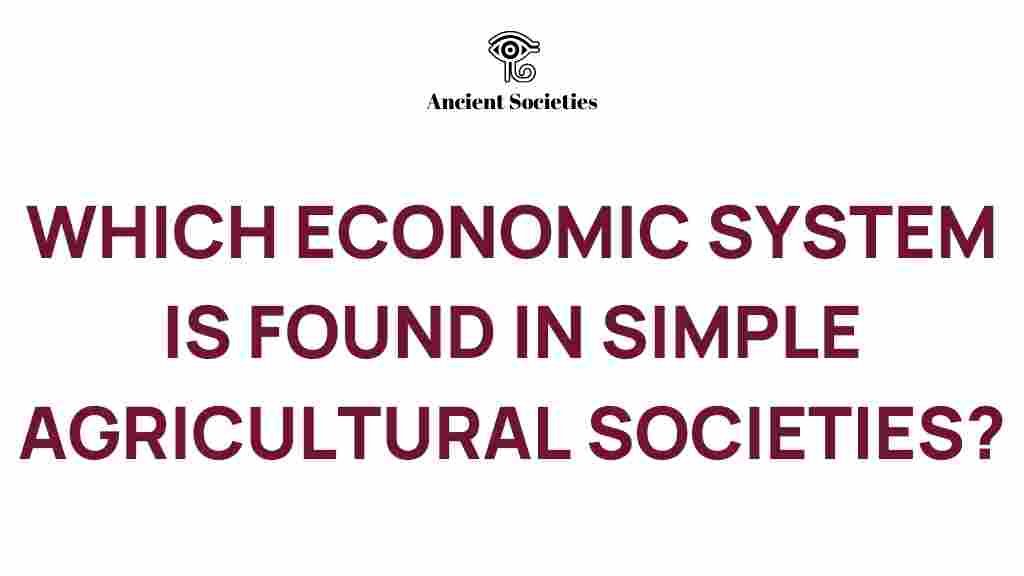Unveiling the Economic Foundations of Simple Agricultural Societies
In the realm of human civilization, few developments have been as transformative as the emergence of simple agricultural societies. These societies have laid the groundwork for the economic systems that we see today. Understanding their economic foundations provides insight into how agriculture, culture, and community have intersected throughout history. In this article, we will explore the intricate relationships between economic systems, subsistence farming, trade, culture, community, resources, and sustainability.
Introduction to Economic Systems in Agriculture
Economic systems define how societies allocate resources and distribute goods and services. In simple agricultural societies, these systems were primarily centered around subsistence farming—where communities produced just enough food to meet their needs. The economic stability of these societies relied on a balance between agricultural practices, resource management, and social structures. This article seeks to delve into these components and their implications for sustainability.
The Role of Agriculture in Economic Systems
Agriculture serves as the backbone of economic systems in simple agricultural societies. The methods and practices of farming have evolved over thousands of years, but the core principles remain centered around producing food. Here are the key aspects:
- Subsistence Farming: This practice involves growing crops primarily for the farmer’s family and local community. It is characterized by low input and output, relying on traditional techniques passed down through generations.
- Crop Diversity: Farmers often grow multiple types of crops to ensure food security and resilience against pests and diseases.
- Seasonal Cycles: Agricultural activities are heavily influenced by seasonal changes, dictating planting and harvesting times.
Community and Culture in Agricultural Societies
In simple agricultural societies, community and culture play crucial roles in shaping economic systems. The interdependence of community members fosters cooperation and collective resource management. Here are some cultural factors that influence these societies:
- Traditions: Cultural practices often dictate farming techniques, seasonal festivals, and rituals associated with agriculture.
- Social Structure: The economic roles within communities are often defined by age, gender, and lineage, impacting how resources are allocated.
- Knowledge Transmission: Oral traditions play a vital role in passing down agricultural knowledge and practices through generations.
Trade and Economic Systems
While subsistence farming is at the heart of simple agricultural societies, trade emerges as a vital component that enhances these economic systems. Trade facilitates the exchange of goods, services, and resources, contributing to the sustainability and growth of local economies. Consider the following:
- Bartering: Communities often engage in bartering, where goods are exchanged directly without the use of currency, promoting local interaction.
- Marketplaces: Local markets serve as hubs for trade, enabling farmers to sell surplus products and acquire necessary resources.
- Resource Sharing: Trade fosters a sense of community by encouraging resource sharing, enhancing social bonds.
Resources and Sustainability
Effective resource management is essential for the sustainability of agricultural societies. The balance between consumption and conservation directly influences the longevity of these communities. Key resource management strategies include:
- Soil Conservation: Practices such as crop rotation and intercropping help maintain soil fertility and prevent erosion.
- Water Management: Efficient irrigation techniques are necessary to ensure adequate water supply for crops, especially in arid regions.
- Agroforestry: Integrating trees into farming systems can enhance biodiversity, improve soil structure, and provide additional resources.
Challenges Faced by Simple Agricultural Societies
Despite their resilience, simple agricultural societies face numerous challenges that threaten their economic systems:
- Climate Change: Shifts in weather patterns can disrupt farming cycles and lead to crop failures.
- Resource Depletion: Overexploitation of natural resources can lead to soil degradation and water scarcity.
- Market Pressures: Globalization and market fluctuations can undermine local economies and traditional farming practices.
Step-by-Step Process for Enhancing Sustainability in Agricultural Societies
To address these challenges and enhance sustainability, simple agricultural societies can adopt a step-by-step approach:
- Assess Resources: Conduct a thorough assessment of available natural resources, including soil, water, and biodiversity.
- Implement Sustainable Practices: Introduce sustainable farming techniques such as permaculture and organic farming.
- Strengthen Community Ties: Foster collaboration among community members to share knowledge and resources effectively.
- Diversify Income Sources: Encourage engagement in complementary activities like handicrafts or eco-tourism to reduce reliance on agriculture alone.
- Advocate for Policies: Work with local governments to promote policies that support sustainable agriculture and protect natural resources.
Troubleshooting Tips for Common Issues
As simple agricultural societies strive for sustainability, they may encounter various obstacles. Here are some troubleshooting tips:
- Problem: Soil Degradation
Solution: Implement cover cropping and reduced tillage to improve soil health. - Problem: Water Scarcity
Solution: Adopt rainwater harvesting techniques and efficient irrigation systems. - Problem: Pest Infestation
Solution: Utilize integrated pest management strategies that combine biological control with cultural practices.
Conclusion: The Path Forward for Simple Agricultural Societies
The economic foundations of simple agricultural societies are deeply intertwined with their cultural and social frameworks. Understanding these relationships is crucial for developing sustainable practices that respect both the environment and community traditions. As we continue to explore the intricate dynamics of agriculture, trade, culture, community, resources, and sustainability, we can work towards a future that honors the lessons of the past while addressing the challenges of tomorrow.
For more information on sustainable agricultural practices, you can visit this resource. To explore further into the impacts of agriculture on modern economies, check out this link.
This article is in the category Society and created by AncientSocieties Team
